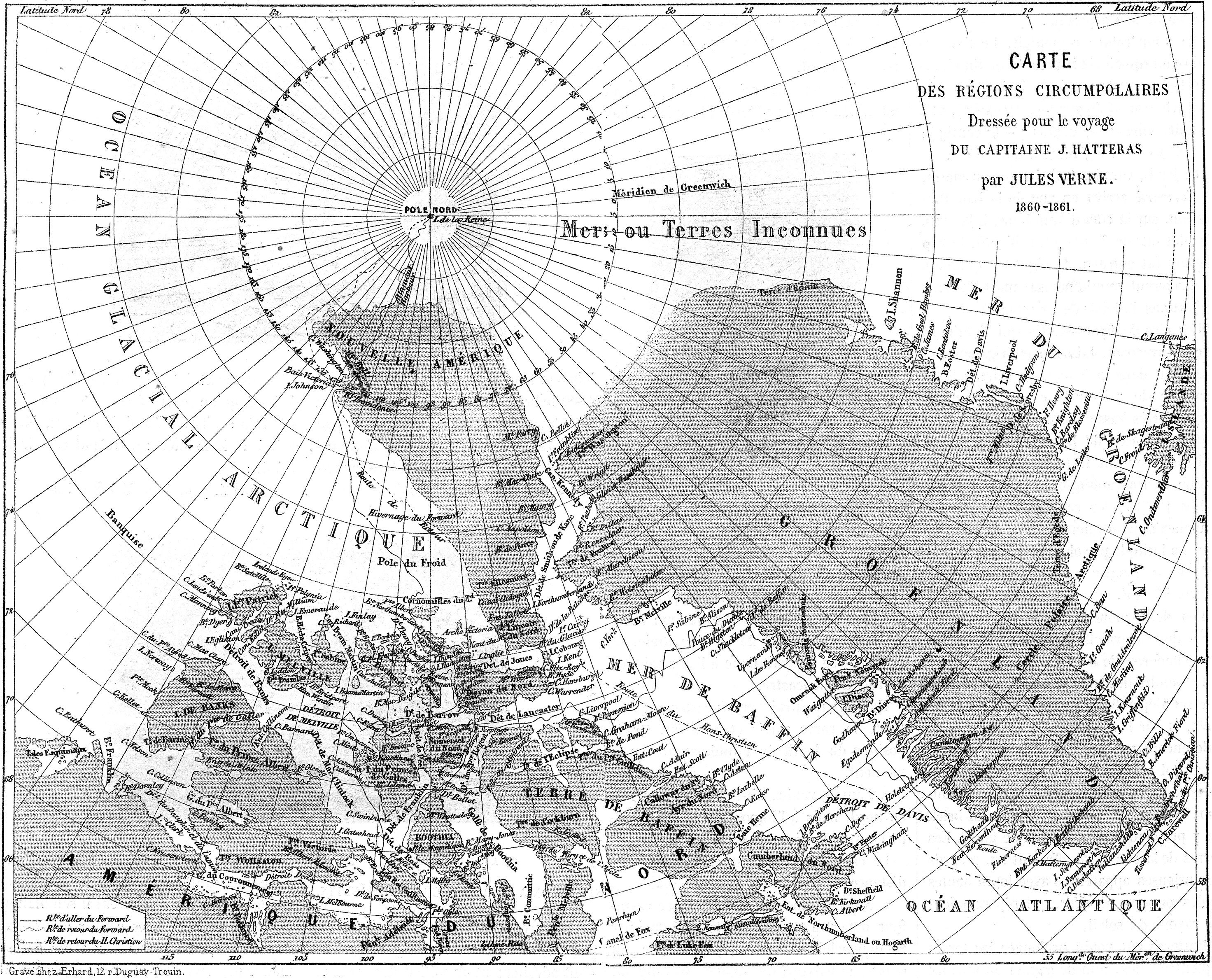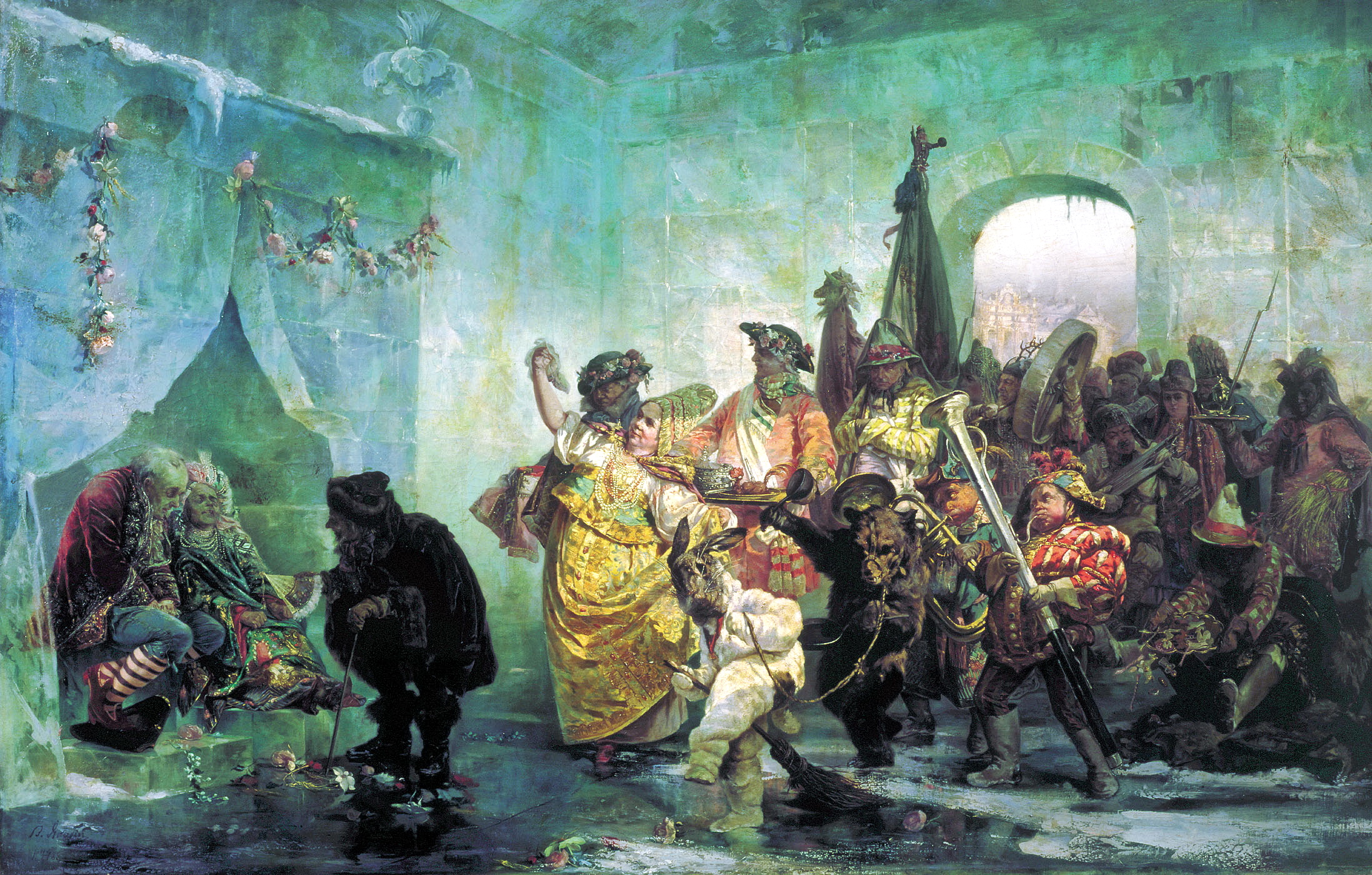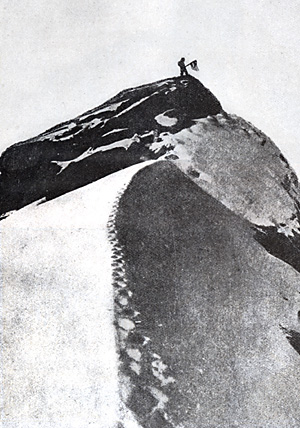|
Voyages Et Aventures Du Capitaine Hatteras
''The Adventures of Captain Hatteras'' (french: Voyages et aventures du capitaine Hatteras) is an adventure novel by Jules Verne in two parts: ''The English at the North Pole'' (french: Les Anglais au pôle nord) and ''The Desert of Ice'' (french: Le Désert de glace). The novel was published for the first time in 1864. The definitive version from 1866 was included in the '' Voyages extraordinaires'' series ("The Extraordinary Voyages"). Although it was the first book of the series, it was labelled as number two. Three of Verne's books from 1863–65 ('' Five Weeks in a Balloon'', ''Journey to the Centre of the Earth'', and '' From the Earth to the Moon'') were added into the series retroactively. Captain Hatteras shows many similarities with the English naval explorer Sir John Franklin. Plot summary The novel, set in 1861, described adventures of British expedition led by Captain John Hatteras to the North Pole. Hatteras is convinced that the sea around the pole is not frozen ... [...More Info...] [...Related Items...] OR: [Wikipedia] [Google] [Baidu] |
Jules Verne
Jules Gabriel Verne (;''Longman Pronunciation Dictionary''. ; 8 February 1828 – 24 March 1905) was a French novelist, poet, and playwright. His collaboration with the publisher Pierre-Jules Hetzel led to the creation of the ''Voyages extraordinaires'', a series of bestselling adventure novels including ''Journey to the Center of the Earth'' (1864), ''Twenty Thousand Leagues Under the Seas'' (1870), and '' Around the World in Eighty Days'' (1872). His novels, always well documented, are generally set in the second half of the 19th century, taking into account the technological advances of the time. In addition to his novels, he wrote numerous plays, short stories, autobiographical accounts, poetry, songs and scientific, artistic and literary studies. His work has been adapted for film and television since the beginning of cinema, as well as for comic books, theater, opera, music and video games. Verne is considered to be an important author in France and most of Europe, where ... [...More Info...] [...Related Items...] OR: [Wikipedia] [Google] [Baidu] |
Ice Palace
An ice palace or ice castle is a castle-like structure made of blocks of ice. These blocks are usually harvested from nearby rivers or lakes when they become frozen in winter. The first known ice palace (or, rather, '' ice house'', ледяной дом in Russian) appeared in St. Petersburg, Russia, when Anna Ivanovna, Empress of Russia, commissioned an ice palace in St. Petersburg, Russia, during the winter of 1739–40. Architect Piotr Eropkin and scientist Georg Wolfgang Krafft used huge ice blocks measuring long by wide, joined together with frozen water, to build the palace. The city recreates the ice palace every winter. Anna Ivanovna's palace In the cold winter of 1739–1740, Anna Ivanovna gave an order to build a palace made of ice in St. Petersburg. The palace and the surrounding festivities were part of the celebration of Russia's victory over the Ottoman Empire. She ordered the architect Pyotr Yeropkin to design the building. [...More Info...] [...Related Items...] OR: [Wikipedia] [Google] [Baidu] |
Frederick Cook
Frederick Albert Cook (June 10, 1865 – August 5, 1940) was an American explorer, physician, and ethnographer who claimed to have reached the North Pole on April 21, 1908. That was nearly a year before Robert Peary, who similarly claimed to have reached the North Pole on April 6, 1909. Both men's accounts have been disputed ever since. His expedition was the first, and the only one with a United States national, to find a previously unknown, to people of European descent, North American Arctic island, Meighen Island. In December 1909, after reviewing Cook's limited records, a commission of the University of Copenhagen ruled his claim unproven. In 1911, Cook published a memoir of his expedition that continued his claim. His account of reaching the summit of Denali (Mount McKinley) in Alaska has also been discredited. Biography Cook was born in Hortonville, New York, in Sullivan County. (His birthplace is sometimes listed as Callicoon or Delaware, both also in Sullivan ... [...More Info...] [...Related Items...] OR: [Wikipedia] [Google] [Baidu] |
Crocker Land
The Crocker Land Expedition took place in 1913. Its purpose was to investigate the existence of Crocker Land, a huge island supposedly sighted by the explorer Robert Peary from the top of Cape Colgate in 1906. It is now believed that Peary fraudulently invented the island. Background Following his 1906 expedition that failed to reach the North Pole, Robert E. Peary reported in his book that he had sighted distant land from the heights of the northwestern shore of Ellesmere Island. He named it Crocker Land, after San Francisco banker George Crocker, one of his financial backers. It is now known that Peary's claim was fraudulent, as he wrote in his diary at the time that no land was visible. The invention of Crocker Land was apparently an attempt to secure further support from Crocker for Peary's 1909 expedition. If so, the attempt failed, as Crocker had diverted all of his available resources to the rebuilding of San Francisco following the 1906 earthquake. The existence or n ... [...More Info...] [...Related Items...] OR: [Wikipedia] [Google] [Baidu] |
Robert Peary
Robert Edwin Peary Sr. (; May 6, 1856 – February 20, 1920) was an American explorer and officer in the United States Navy who made several expeditions to the Arctic in the late 19th and early 20th centuries. He is best known for, in April 1909, leading an expedition that claimed to be the first to have reached the geographic North Pole. Explorer Matthew Henson, part of the expedition, is thought to have reached what they believed to be the North Pole narrowly before Peary. Peary was born in Cresson, Pennsylvania, but, following his father's death at a young age, was raised in Portland, Maine. He attended Bowdoin College, then joined the United States Coast and Geodetic Survey as a draftsman. He enlisted in the navy in 1881 as a civil engineer. In 1885, he was made chief of surveying for the Nicaragua Canal, which was never built. He visited the Arctic for the first time in 1886, making an unsuccessful attempt to cross Greenland by dogsled. In the Peary expedition to Green ... [...More Info...] [...Related Items...] OR: [Wikipedia] [Google] [Baidu] |
Isaac Israel Hayes
Isaac Israel Hayes (March 5, 1832 – December 17, 1881) was an American Arctic explorer, physician, and politician, who was appointed as the commanding officer at Satterlee General Hospital during the American Civil War, and was then elected, after the war, to the New York State Assembly. In 1863, Hayes was elected as a member to the American Philosophical Society. His book, ''The Open Polar Sea: A Narrative of a Voyage of Discovery towards the North Pole, in the Schooner United States'', was published in 1867. Formative years and Arctic exploration Born in Chester County, Pennsylvania on March 5, 1832, Hayes was raised on his family's farm before being sent to the coeducational Westtown School, which had been founded in Chester County in 1799 by the Religious Society of Friends (Quakers). Electing to remain there for two years following his graduation, he became an assistant teacher of civil engineering and mathematics. In 1851, he sought and received admission to the Univer ... [...More Info...] [...Related Items...] OR: [Wikipedia] [Google] [Baidu] |
Edward Augustus Inglefield
Sir Edward Augustus Inglefield (27 March 1820 – 4 September 1894) was a Royal Navy officer who led one of the searches for the missing Arctic explorer John Franklin during the 1850s. In doing so, his expedition charted previously unexplored areas along the northern Canadian coastline, including Baffin Bay, Smith Sound and Lancaster Sound. He was also the inventor of the marine hydraulic steering gear and the anchor design that bears his name. bears his name, as do the Inglefield Land region and the Inglefield Gulf of Greenland. Career First voyage to the Arctic Inglefield set out from Britain on his search in July 1852, commanding Jane Franklin, Lady Franklin's private steamer , seven years after Sir John Franklin had left on his ill-fated search for the fabled Northwest Passage. Once Inglefield had reached the Arctic, a search and survey of Greenland's west coast was made; Ellesmere Island was resighted and named in honour of the president of the Royal Geographic ... [...More Info...] [...Related Items...] OR: [Wikipedia] [Google] [Baidu] |
Ellesmere Island
Ellesmere Island ( iu, script=Latn, Umingmak Nuna, lit=land of muskoxen; french: île d'Ellesmere) is Canada's northernmost and List of Canadian islands by area, third largest island, and the List of islands by area, tenth largest in the world. It comprises an area of , slightly smaller than Great Britain, and the total length of the island is . Lying within the Arctic Archipelago, Ellesmere Island is considered part of the Queen Elizabeth Islands. Cape Columbia at 83°06′ is the northernmost point of land in Canada and one of the northernmost points of land on the planet (the northernmost point of land on Earth is the nearby Kaffeklubben Island of Greenland). The Arctic Cordillera mountain system covers much of Ellesmere Island, making it the most mountainous in the Arctic Archipelago. More than one-fifth of the island is protected as Quttinirpaaq National Park. In 2021, the population of Ellesmere Island was recorded at 144. There are three settlements: Alert, Nunavut, Aler ... [...More Info...] [...Related Items...] OR: [Wikipedia] [Google] [Baidu] |
Map From Journeys And Adventures Of Captain Hatteras By Jules Verne
A map is a symbolic depiction emphasizing relationships between elements of some space, such as objects, regions, or themes. Many maps are static, fixed to paper or some other durable medium, while others are dynamic or interactive. Although most commonly used to depict geography, maps may represent any space, real or fictional, without regard to context or scale, such as in brain mapping, DNA mapping, or computer network topology mapping. The space being mapped may be two dimensional, such as the surface of the earth, three dimensional, such as the interior of the earth, or even more abstract spaces of any dimension, such as arise in modeling phenomena having many independent variables. Although the earliest maps known are of the heavens, geographic maps of territory have a very long tradition and exist from ancient times. The word "map" comes from the , wherein ''mappa'' meant 'napkin' or 'cloth' and ''mundi'' 'the world'. Thus, "map" became a shortened term referring t ... [...More Info...] [...Related Items...] OR: [Wikipedia] [Google] [Baidu] |
Fjord
In physical geography, a fjord or fiord () is a long, narrow inlet with steep sides or cliffs, created by a glacier. Fjords exist on the coasts of Alaska, Antarctica, British Columbia, Chile, Denmark, Germany, Greenland, the Faroe Islands, Iceland, Ireland, Kamchatka, the Kerguelen Islands, Labrador, Newfoundland, New Zealand, Norway, Novaya Zemlya, Nunavut, Quebec, the Patagonia region of Argentina and Chile, Russia, South Georgia Island, Tasmania, United Kingdom, and Washington state. Norway's coastline is estimated to be long with its nearly 1,200 fjords, but only long excluding the fjords. Formation A true fjord is formed when a glacier cuts a U-shaped valley by ice segregation and abrasion of the surrounding bedrock. According to the standard model, glaciers formed in pre-glacial valleys with a gently sloping valley floor. The work of the glacier then left an overdeepened U-shaped valley that ends abruptly at a valley or trough end. Such valleys are fjords wh ... [...More Info...] [...Related Items...] OR: [Wikipedia] [Google] [Baidu] |
Volcano
A volcano is a rupture in the crust of a planetary-mass object, such as Earth, that allows hot lava, volcanic ash, and gases to escape from a magma chamber below the surface. On Earth, volcanoes are most often found where tectonic plates are diverging or converging, and most are found underwater. For example, a mid-ocean ridge, such as the Mid-Atlantic Ridge, has volcanoes caused by divergent tectonic plates whereas the Pacific Ring of Fire has volcanoes caused by convergent tectonic plates. Volcanoes can also form where there is stretching and thinning of the crust's plates, such as in the East African Rift and the Wells Gray-Clearwater volcanic field and Rio Grande rift in North America. Volcanism away from plate boundaries has been postulated to arise from upwelling diapirs from the core–mantle boundary, deep in the Earth. This results in hotspot volcanism, of which the Hawaiian hotspot is an example. Volcanoes are usually not created where two tectonic plates slide ... [...More Info...] [...Related Items...] OR: [Wikipedia] [Google] [Baidu] |
Black Powder
Gunpowder, also commonly known as black powder to distinguish it from modern smokeless powder, is the earliest known chemical explosive. It consists of a mixture of sulfur, carbon (in the form of charcoal) and potassium nitrate (saltpeter). The sulfur and carbon act as fuels while the saltpeter is an oxidizer. Gunpowder has been widely used as a propellant in firearms, artillery, rocketry, and pyrotechnics, including use as a blasting agent for explosives in quarrying, mining, building pipelines and road building. Gunpowder is classified as a low explosive because of its relatively slow decomposition rate and consequently low brisance. Low explosives deflagrate (i.e., burn at subsonic speeds), whereas high explosives detonate, producing a supersonic shockwave. Ignition of gunpowder packed behind a projectile generates enough pressure to force the shot from the muzzle at high speed, but usually not enough force to rupture the gun barrel. It thus makes a good propellant but is ... [...More Info...] [...Related Items...] OR: [Wikipedia] [Google] [Baidu] |




.jpg)


.jpg)

